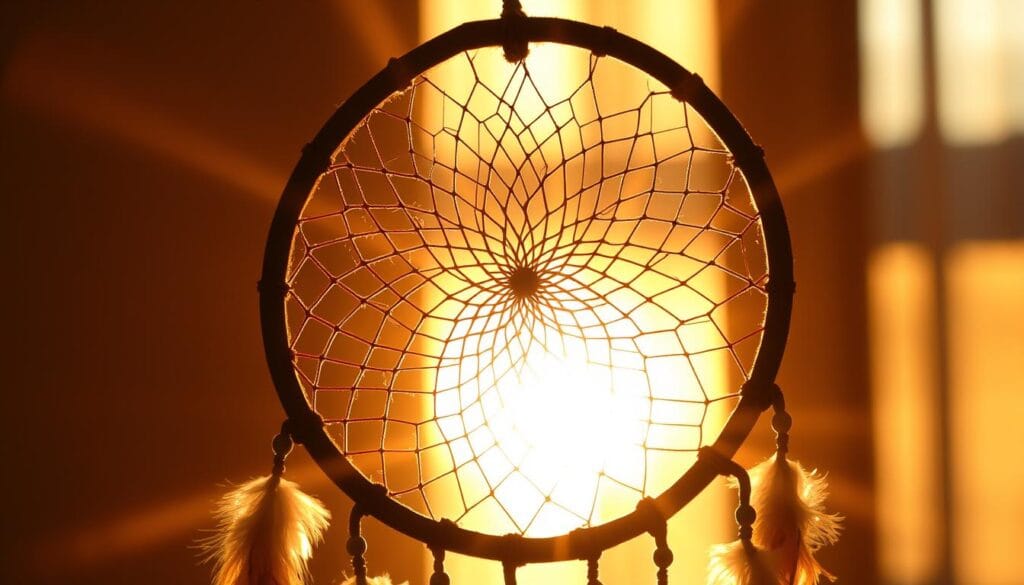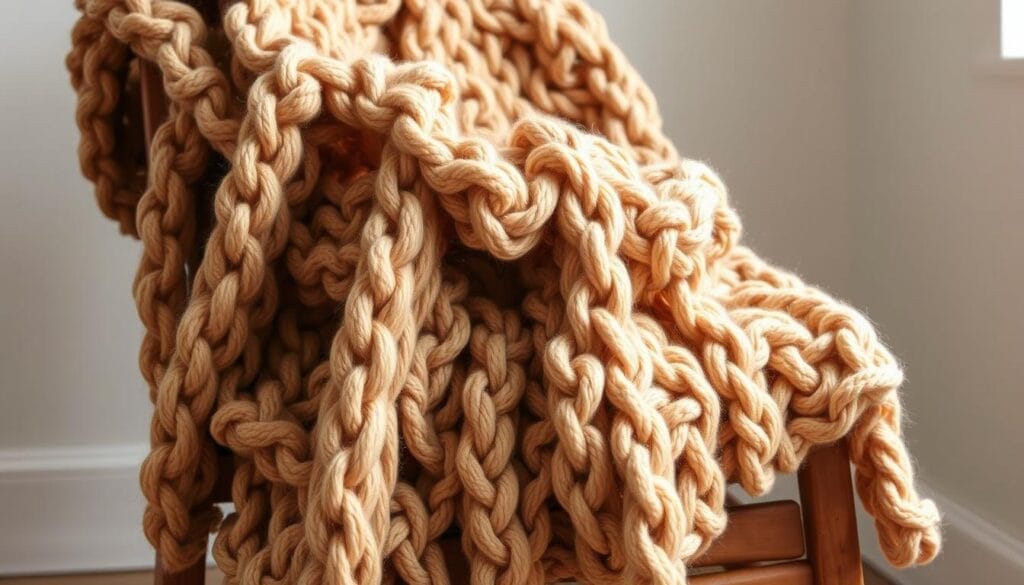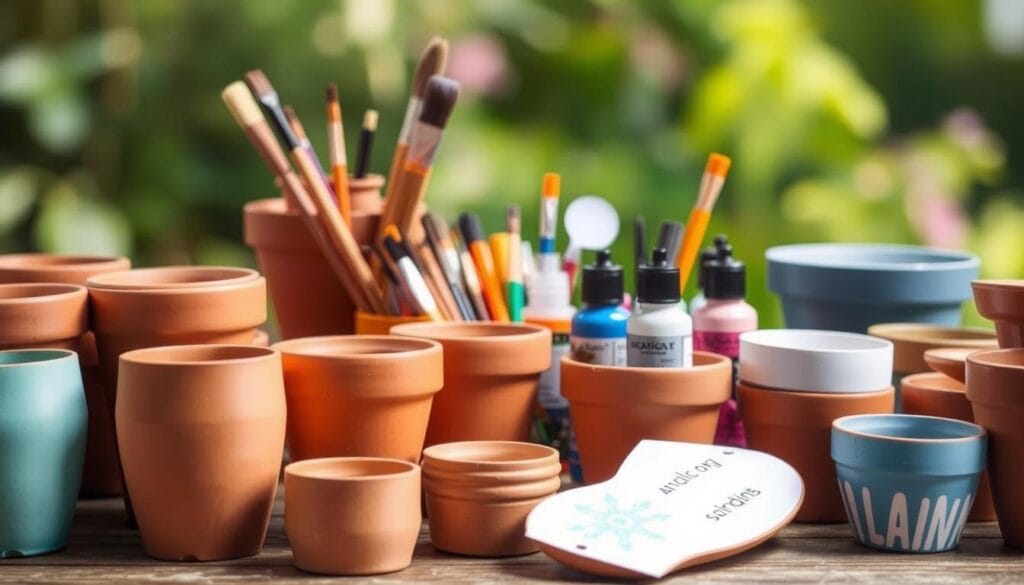We all remember nights full of wild adventures or comforting moments in our dreams. Crafting a DIY dreamcatcher brings back memories of eclectic bohemian apartments and festival tents from the 1960s and 1970s. These mystical objects, loved by hippies, actually come from Native American traditions.
Picture yourself in your cozy living room on a rainy day, drinking hot tea and starting a dreamcatcher tutorial. Wrapping suede lace around a 5-inch hoop feels soothing. By adding feathers and twine, you make this simple craft meaningful. Dreamcatchers were meant to keep away bad dreams, letting only good dreams slip through. This is a reassuring idea for anyone wanting peaceful sleep.
Making a dreamcatcher is a therapeutic journey that mixes tradition with modern style. Adding calming Amazonite beads or wrapping the hoop exactly twelve times turns it into art. Whether for your room or as a gift, a dreamcatcher means care, creativity, and a sprinkle of magic.
Ready to start this delightful DIY dreamcatcher project? Follow our step-by-step guide for a smooth and fun creation process. Your dreamcatcher will catch beautiful dreams. 🌙✨
Introduction to Dreamcatchers
Dreamcatchers come from Native American culture, mainly the Ojibwe tribe. Originally, they were made to shield infants from nightmares. Each dreamcatcher has a round hoop that stands for the Earth. This shows how nature is all connected in Native American beliefs. Early dreamcatchers were small and hung over cribs for both protection and spiritual reasons.
Now, dreamcatcher designs have grown and changed. They keep their cultural importance but now include different materials and styles. This invites more people to enjoy them. People add beads, charms, and feathers to make them personal. For DIY lovers, making dreamcatchers is a great way to mix tradition with your own creative flair.
The process to make a dreamcatcher is detailed and can take days. Makers use yarn, string like hemp, and decorations like beads and feathers. The hoop’s size can change. Often, a 6-inch hoop is used, but the ties and decor vary by person.
Ready to make a dreamcatcher? Start with a tree branch about 3-foot long and a quarter-inch thick. Adding twine, peacock feathers, and lace lets you make it your own. This project links us to the dreamcatcher’s deep history. And it lets us craft something both special and personal.
Want to try making a dreamcatcher? Visit this guide for a step-by-step DIY. It has all you need to know, from picking materials to crafting. This way, you’re joining others who love the tradition and creativity of dreamcatchers.
Materials Needed for Your Dreamcatcher
Making a dreamcatcher is a fun way to add beauty and meaning to your room. Here’s what you’ll need to begin this creative journey.
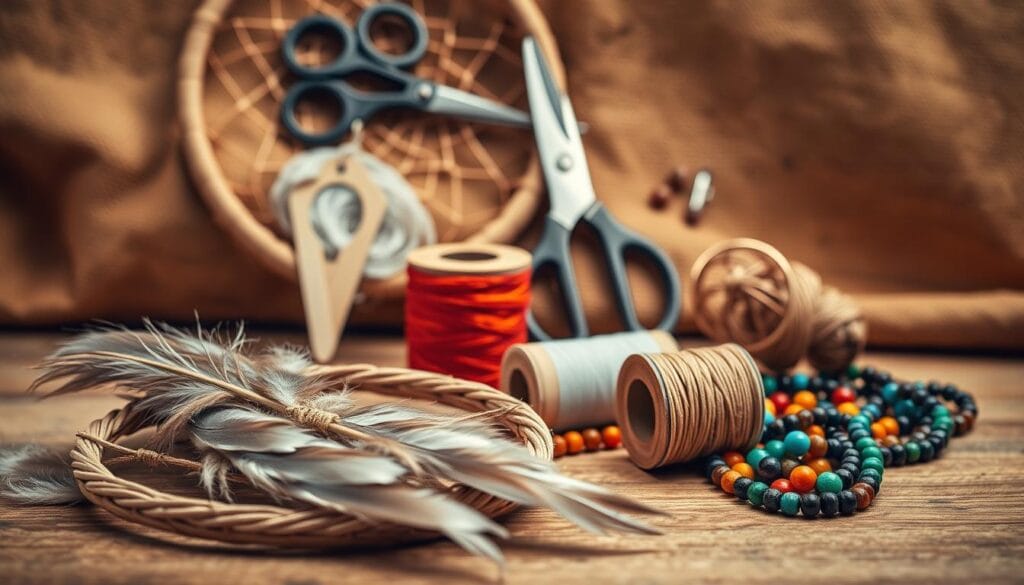
- Hoops: Pick between a metal or embroidery hoop. If you’re new, opt for a size ranging from 5 to 8 inches (13 to 20 cm). This choice lets you design the dreamcatcher to match your creativity.
- Suede Lace: Get lace that’s 18 times your hoop’s diameter. For a hoop of 5 inches (13 cm), you’ll need about 2.5 yards (2.3 m). Stick with lace under 0.5 inches (1.27 cm) wide for easy use.
- String or Twine: This is for the web. Use string 10 times the hoop’s diameter. For a 5-inch (13 cm) hoop, you need 50 inches (127 cm) of string. Make sure loops are 2 inches (5 cm) apart.
- Embroidery Needle: It’s for weaving the web inside your dreamcatcher.
- Feathers and Wooden Beads: Add feathers and beads for extra beauty. Usually, you group together 4 to 5 feathers for decoration.
- Glue Gun and Hot Glue: Use this to stick the twine to the hoop. Apply glue every inch to make it secure.
- Scissors: You’ll need these to cut string, lace, and other things to size.
- Binder Clips: About 4 small binder clips can hold the lace while you wrap it around the hoop.
You can choose between natural or synthetic materials. For a natural look, go for goose feathers (in white/gold, pink/white/gold), peacock feathers, and wood beads. Or, pick colorful satin lace trim in 1/4″ and 5/8″ widths for a synthetic option. Both types are great for making a unique and lovely dreamcatcher.
The center of your dreamcatcher should be as big as a penny or dime. This size is not just pretty but functional too. Dreamcatchers are meant to let good dreams pass and trap bad ones.
With these essential crafting tools, you’re ready to make a dreamcatcher that’s both pretty and full of meaning. Enjoy crafting! 🌟
Selecting the Perfect Hoop Size
Choosing the right dreamcatcher hoop is critical for both looks and function. With different sizes for different styles, many aspects come into play.
- The average size of a dreamcatcher bought online ranges from 10 to 24 inches across. Eighteen inches is the most popular, making up 35% of sales.
- Smaller hoops, from 3 to 8 inches, are good for traditional designs. They work well with materials like dried red willow or grapevine.
- When using a big hoop, the suede lacing length should be eight times the hoop’s diameter. This ensures it wraps around properly.
- The look you want, bold or subtle, will guide your hoop size choice.
Small hoops, about 3 to 8 inches, fit well in cozy spots or for a simple look. Bigger hoops, up to 24 inches, make a bold statement. For bead placement, aim for beads in every other gap for a balanced look.
Every choice, including hoop size, makes your dreamcatcher unique. Whether for a bedroom, living area, or by doors and windows, choose wisely. Embrace choosing dreamcatcher size. Let different sizes for different styles blend with your intended space and purpose.
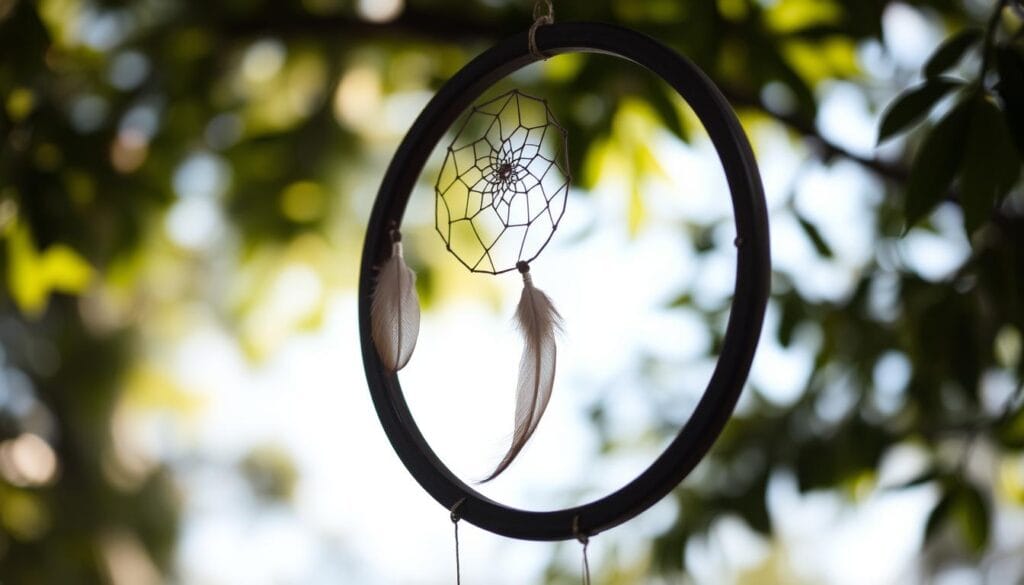
For web weaving, use string ten times longer than the hoop’s length. This helps in crafting complex designs. For a 3-inch hoop, start with eight knots. For bigger hoops, start with eight knots and double it on the next row for 16 knots in total. Place each hitch in the thread’s center between knots.
The choice of different sizes for different styles impacts your dreamcatcher’s look and vibe. Happy crafting!
Choosing Your Dreamcatcher Design
Choosing the right dreamcatcher design means picking between traditional and modern styles. Traditional dreamcatchers come from Native American culture. They usually have a simple web in a solid hoop with feathers and beads. These honor the dreamcatcher’s roots in the Anishinaabe and Ojibwe cultures.
If you prefer traditional styles, think about using leather or buckskin suede for the hoop. Keep it between 5 to 8 inches. They often have four or five feathers and sometimes beads or shells, following the Spider Woman legend from 1929.
Modern dreamcatchers, however, offer a chance to be creative. They use different materials and designs. You can go for a boho look or something simple, using hoops from 8 to 10 inches. The choices in materials like metal hoops and colorful threads are endless.
Both traditional and modern dreamcatchers have their unique appeal. The old-style links us to the dreamcatcher’s heritage, known for guarding against harm. Modern ones let us express our creativity and fit better with current decor styles.
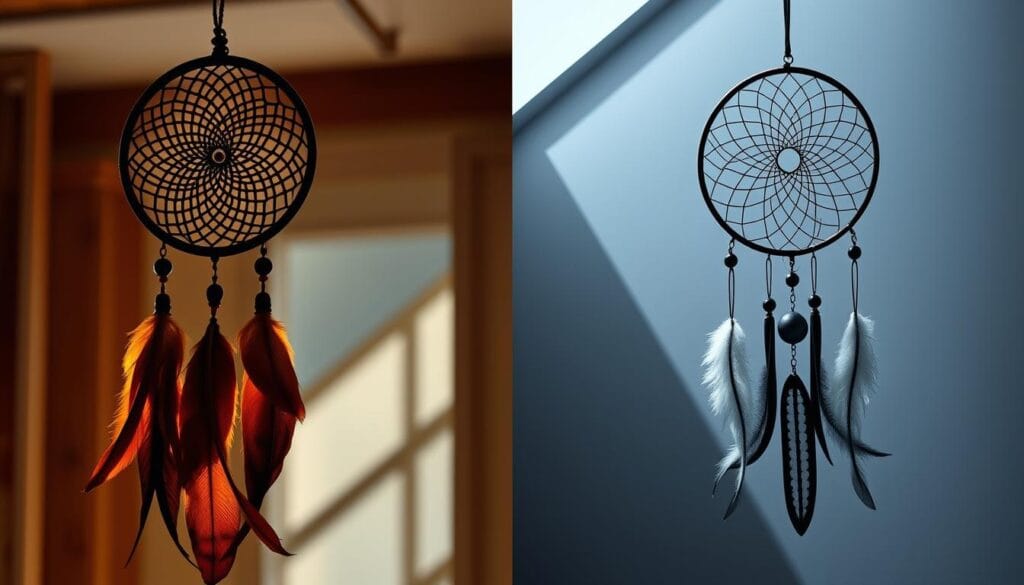
To choose what’s best for you, here’s a side-by-side of traditional and modern dreamcatcher elements:
| Aspect | Traditional Dreamcatcher | Contemporary Dreamcatcher |
|---|---|---|
| Hoop Material | Leather, Buckskin Suede Lace | Metal, Cane, Pipe Cleaners |
| Hoop Size | 5 to 8 inches | 8 to 10 inches |
| Web Pattern | Simple, Spiderweb-like | Varied Patterns |
| Decorations | Feathers, Beads | Charms, Diverse Beads |
| Materials for Wrapping | Leather, Sinew | Various Threads, Ribbons |
Your dreamcatcher should mirror your personal style and creativity. Whether you like the classic or modern look, dive into your project with joy. Explore, imagine, and most importantly, enjoy making your dreamcatcher!
Step-by-Step Crafting Process
Let’s start making a dreamcatcher! First, get an embroidery hoop, macrame cord, and a few other things. To figure out how much cord you need, measure your hoop’s circumference and multiply by four. If the hoop is 12 inches around, you’ll need 48 inches of cord.
With your cord in hand, wrap it around the hoop. Use a bit of masking tape to hold the end. Make sure the cord is tight and even as you go.
“A well-prepared base is crucial for a stunning craft. Focus on neat and tight wrapping for a flawless finish.”
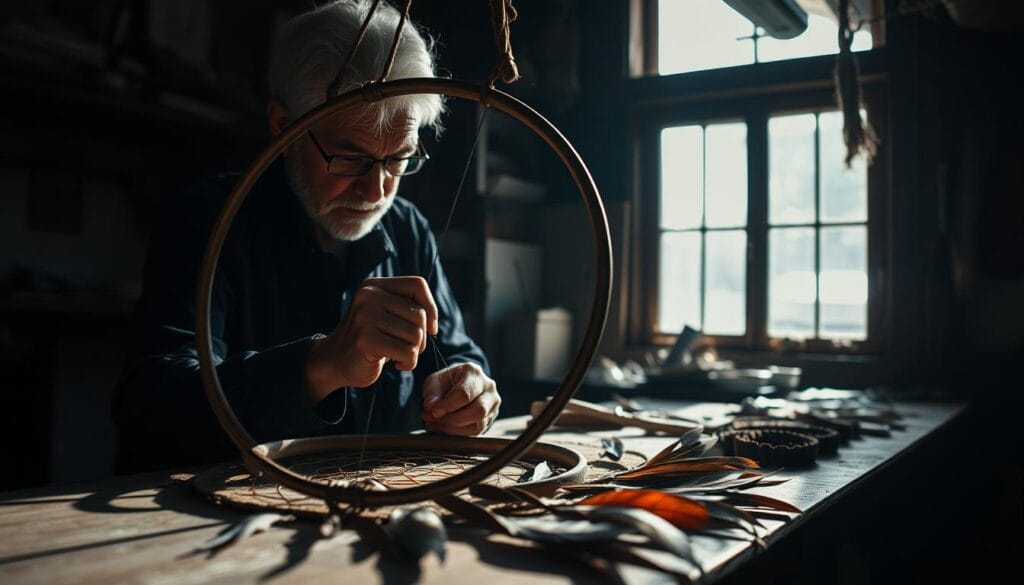
Now, onto the knots. Start with an Overhand Knot, which is quick, taking maybe 30 seconds if you know how! After that, begin weaving the web. This part feels meditative and rewarding. Work to make a neat pattern of loops around the hoop’s edge.
To make your dreamcatcher stand out, add beads and feathers. Try a pattern with beads of different sizes for balance. GANXXET Macrame Cord comes in many colors for your creation. Here’s a great tutorial for macrame dream catchers for more ideas.
Adding your own touches makes the dreamcatcher truly yours. Use different materials like wooden rings or crystals. Let your imagination guide you to create a piece that shows your style. For more DIY decor ideas, check out this list of easy projects.
With the right materials and some patience, you can finish your dreamcatcher in about an hour. The design allows good dreams to pass through the center while catching bad ones in the web. Enjoy making it and the beautiful result!
Incorporating Feathers and Beads
Adding feathers and beads to your dreamcatcher lets you show off your creative side. You can use different types of feathers to make your creation stand out. Many who enjoy DIY projects love to mix various colors and textures. This adds a personal touch that shows their style and purpose.
When picking feathers, think about using natural ones for a traditional look. Or choose vivid, dyed feathers to complement your decor. Peacock, pheasant, and goose feathers are among the favorites. They bring a special touch to your dreamcatcher. The design usually has about three feathers on each side for a balanced look.
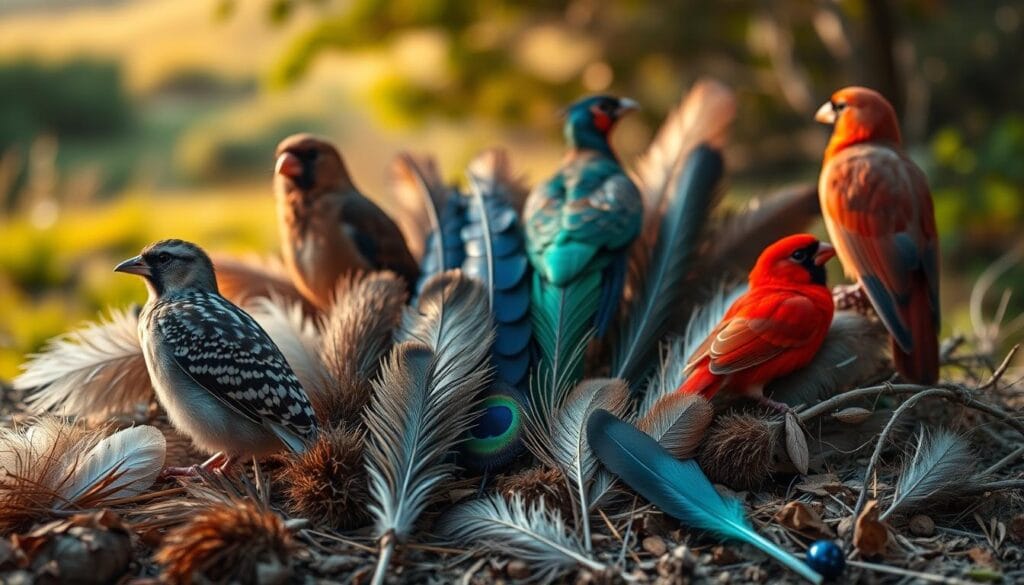
Adding beads to your dreamcatcher also adds charm and makes it personal. You can choose from wooden, glass, or plastic beads. Adding sequin ribbons and tassels has become more popular, growing by 25%. This shows people like adding detailed and textured decorations to their crafts.
Here are some creative ways to attach beads:
- Thread beads onto the strings of the dreamcatcher’s web.
- Put beads on feather ends for extra shimmer.
- Glue larger beads and sequins onto the dreamcatcher’s hoop with craft glue.
The mix of beads and feathers can turn a basic dreamcatcher into an eye-catching artwork. Whether you prefer the sleek look of tiny glass beads or the vibrant effect of colorful plastic ones, your choices make your dreamcatcher unique.
Happy crafting! Can’t wait to see your beautiful dreamcatchers decorated with feathers and beads!
Customizing Your Dreamcatcher
Creating a dreamcatcher is more than making art. It’s like showing off your unique personality! You can start by painting the hoop. This adds a colorful foundation for your design. Imagine splashing your hoop with bright colors or soft pastels. A well-painted hoop not only looks cool but also showcases your personal style.
There are many ways to decorate the hoop. Want a bit of sparkle? Try wrapping it with sequins or shiny threads. If you prefer a rustic vibe, twine and lace can add a vintage charm to your dreamcatcher.
You can also make your dreamcatcher truly yours by adding personal symbols. Attach charms or items from your travels to the web or let them hang off the hoop. Every piece added tells a part of your story, making your dreamcatcher a narrative of your life and dreams.
Traditional touches like feathers and beads are great, but there’s more to explore. Consider using nature-inspired items, like dried flowers, for a whimsical look. Or, for a modern twist, use simple, geometric shapes. The key is to enjoy the journey of crafting something that expresses your creativity.
Let’s talk about the cost of making a dreamcatcher. On average, a simple DIY dreamcatcher costs about $6, assuming you already have glue and scissors. A wooden hoop may cost you about $3, and white string around $5. Adding faux pearls? That’s less than $1 for 20 beads.
To give you a better idea, here’s a quick list of some common supplies and their costs:
| Item | Estimated Cost |
|---|---|
| Wooden Hoop | $3 |
| White String | $5 |
| Faux Pearls (20 beads) | Less than $1 |
| Craft Feathers (60-pack) | $6 |
Making a basic dreamcatcher takes about 30 minutes, but more complex designs can take up to 2 hours. So, gather your supplies, let your creativity flow, and enjoy making a dreamcatcher that’s perfectly you!
Hanging and Displaying Your Dreamcatcher
Choosing the best locations for visibility and protection is key for your dreamcatcher. They were originally put above beds to sift through dreams. This ensured that only good dreams reached the sleeper. For visibility, consider places like your office, meditation area, or car. Each spot brings its own benefits and boosts the dreamcatcher’s look.
For spiritual safeguarding, putting your dreamcatcher in your garden, porch, or doorway works well. Feng Shui suggests placing it where air moves freely, inviting positive vibes. To hang it securely, you’ll need a ceiling hook or durable string, plus some tools. Scissors and a stud finder make the setup easy and safe.
To see how different spots affect your dreamcatcher, look at the table below. It shows where to place them and why:
| Location | Benefit |
|---|---|
| Above the bed | Filters dreams and promotes restful sleep |
| Office | Enhances aesthetic presence and productivity |
| Meditation Area | Symbolizes peace and spiritual protection |
| Car | Provides protection and aesthetic appeal |
| Garden/Porch | Symbolizes connection to nature and positive energy flow |
| Doorway | Offers protection and a welcoming presence |
If you’re putting your dreamcatcher outside, choose materials that stand up to weather. Use an overhang to keep it safe from water and sun. Small dreamcatchers work well in cozy spots. Bigger ones, over 12 inches, make great focal points. Where you place your dreamcatcher affects its spiritual and aesthetic value. Aim for the best locations for visibility and protection to get the most out of it.
Care and Maintenance of Your Dreamcatcher
Dreamcatchers come from the Ojibwe people and have been loved for centuries. Today, they are adored for their beauty and meaning. To keep them looking good and working well, it’s important to know how to clean and refresh your creation.
It’s best to cleanse dreamcatchers monthly. This stops negative energy from building up. A good way to do this is by placing your dreamcatcher in the sunlight for a few hours. Sunlight naturally purifies. For those making a dreamcatcher, this step is key, no matter the design.
Dusting regularly keeps your dreamcatcher looking great. Use something soft to dust the feathers and web. If dirt sticks, lightly wipe with a damp cloth.
If your dreamcatcher is damaged or has moldy feathers, it may need repairs. Throw away moldy dreamcatchers to stay healthy. For small fixes, you can reweave the web or fix beads and feathers.
Caring for your dreamcatcher regularly makes it last longer. Avoid direct sun to keep materials from fading. Vacuuming your room can also keep negative energy away. This helps your dreamcatcher work better.
Below is a helpful guide for caring for dreamcatchers:
| Care Method | Purpose | Frequency |
|---|---|---|
| Sunlight Exposure | Purifies and removes negative energy | Once a month |
| Dusting | Removes accumulated dust and dirt | Weekly |
| Moist Cloth Wipe | Clean stubborn dirt | As needed |
| Repairing Webbing | Fixes damaged areas to maintain function | As needed |
Follow these tips to know how to clean and refresh your creation. This way, your dreamcatcher will stay beautiful and protective.
Gift Ideas Featuring Dreamcatchers
Nothing tops the charm of personalized dreamcatchers for memorable presents. Handmade gifts are becoming more popular than store-bought ones. They show a deeper personal connection. Robin Wall Kimmerer says that giving and receiving gifts creates lasting relationships. This is more meaningful than just buying things. So, let’s see how to make dreamcatchers special for gifts!
Add items with personal meanings, like beads or feathers, to make these gifts extra special. Spending days or weeks on a dreamcatcher shows your care and love. People love handmade gifts the most because they show how much you care. This shows a move towards loving the thought more than the price.
- Custom Themed Dreamcatchers: Design them around the recipient’s likes or hobbies. Use nature items like leaves and flowers for someone who loves the outdoors.
- Memory Catchers: Add small keepsakes, like photos or charms, to the dreamcatcher. It will be a treasure filled with memories for the receiver.
- Color-Coded Designs: Pick the person’s favorite colors for the dreamcatcher. It shows you know and care about their preferences.
Presenting your dreamcatcher gift nicely adds to its magic. Here are some creative ideas:
| Presentation Idea | Description |
|---|---|
| Decorative Boxes | Put the dreamcatcher in a pretty box that can be reused. It’s a fun surprise that’s also useful. |
| Personalized Notes | Add a note explaining the dreamcatcher’s special elements. It makes your gift even more touching. |
| Themed Wrapping Paper | Use wrapping paper that matches the recipient’s tastes or interests. It’s a lovely final touch for your thoughtful gift. |
Dreamcatcher gifts are a unique way to show you care. Let’s keep the tradition of giving alive for holidays, birthdays, and other special times. Create gifts that will be loved and remembered for years!
Conclusion and Final Thoughts
We hope you loved learning about dreamcatchers with us. From choosing materials to mastering weaving, our guide has shown you how to create stunning pieces. These aren’t just decorations. They connect us to the deep traditions of the Indigenous North American cultures, especially the Ojibwe.
Making dreamcatchers is about more than just following directions. It’s about the joy of creating and giving them away. Whether for fun, to decorate, or as special gifts, making them boosts creativity and improves your skills. Add your own touch with feathers, beads, or even recycled items. Also, keeping them clean and out of the sun keeps them looking great.
Take what you’ve learned and apply it to new projects. The happiness from making and giving these dreamcatchers shows the power of creativity and community. Keep exploring, stay creative, and always find the beauty in your crafts. Until we meet again, happy crafting! 🌟

